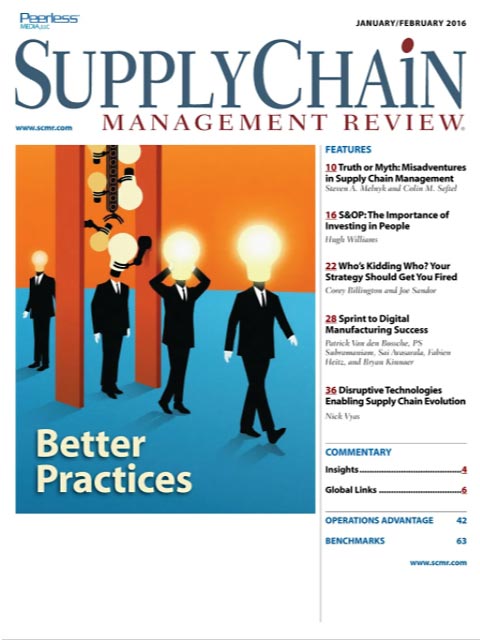Sorry, but your login has failed. Please recheck your login information and resubmit. If your subscription has expired, renew here.
January-February 2016
It’s a new year. Most of us will have new budgets to meet and new expectations for the performance of our supply chains. Many will look to best practices from industry leaders to improve our operations. But, are best practices really the “best” way to go? As you think about 2016, I hope you ask the question: What better practices can I adopt for my supply chain? Browse this issue archive.Need Help? Contact customer service 847-559-7581 More options
The next wave of manufacturing innovation will come from the Internet of Things. Indeed, connected networks of factory hardware are already enhancing process transparency and enabling previously untapped analytics in several plants. Wearable technologies have the opportunity to further improve operational efficiencies. Also known as wearables, the term refers to devices, often connected to the Internet or to other devices that are worn on the body and can be used to enhance communication to and from the users.
Wearables are likely to be adopted quickly, given the potential benefits in communication, productivity, and safety—and depending on the type of technology that’s employed. For example, communication can be improved through smart glasses or voice command devices. Step-by-step manufacturing instructions can be transmitted visually through smart glasses, while two-way audio headsets can give users real-time notifications pertinent to their activities on the floor.
Productivity increases from wearable voice command tools can increase factory warehouse efficiencies up to 30 percent, according to vendors of the technology. Other wearables can monitor health and stress levels of employees through fitness trackers, while GPS and beacon technology can easily locate employees and prevent them from entering a dangerous zone, such as machine cages and boilers.
 |
This complete article is available to subscribers
only. Click on Log In Now at the top of this article for full access. Or, Start your PLUS+ subscription for instant access. |
SC
MR
Sorry, but your login has failed. Please recheck your login information and resubmit. If your subscription has expired, renew here.
January-February 2016
It’s a new year. Most of us will have new budgets to meet and new expectations for the performance of our supply chains. Many will look to best practices from industry leaders to improve our operations. But, are… Browse this issue archive. Access your online digital edition.
 |
Download Article PDF |
The next wave of manufacturing innovation will come from the Internet of Things. Indeed, connected networks of factory hardware are already enhancing process transparency and enabling previously untapped analytics in several plants. Wearable technologies have the opportunity to further improve operational efficiencies. Also known as wearables, the term refers to devices, often connected to the Internet or to other devices that are worn on the body and can be used to enhance communication to and from the users.
Wearables are likely to be adopted quickly, given the potential benefits in communication, productivity, and safety—and depending on the type of technology that's employed. For example, communication can be improved through smart glasses or voice command devices. Step-by-step manufacturing instructions can be transmitted visually through smart glasses, while two-way audio headsets can give users real-time notifications pertinent to their activities on the floor.
Productivity increases from wearable voice command tools can increase factory warehouse efficiencies up to 30 percent, according to vendors of the technology. Other wearables can monitor health and stress levels of employees through fitness trackers, while GPS and beacon technology can easily locate employees and prevent them from entering a dangerous zone, such as machine cages and boilers.
 |
SUBSCRIBERS: Click here to download PDF of the full article. |
SC
MR

Latest Supply Chain News
- Tips for CIOs to overcome technology talent acquisition troubles
- There is still work to do to achieve supply chain stability
- Blooming success: The vital role of S&OE in nurturing global supply chains
- Supply chain salaries, job satisfaction on the rise
- How one small part held up shipments of thousands of autos
- More News
Latest Podcast

 Explore
Explore
Topics
Latest Supply Chain News
- Tips for CIOs to overcome technology talent acquisition troubles
- There is still work to do to achieve supply chain stability
- Blooming success: The vital role of S&OE in nurturing global supply chains
- Supply chain salaries, job satisfaction on the rise
- How one small part held up shipments of thousands of autos
- Investor expectations influencing supply chain decision-making
- More latest news
Latest Resources

Subscribe

Supply Chain Management Review delivers the best industry content.

Editors’ Picks





